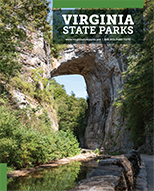Read Our Blogs
Magnificent Moths of Mason Neck
Shared by Ariel Hartman - Assistant Park Manager, as Guest Blogger.
As the weather is warming up, there are many creatures at Mason Neck State Park that visitors come to see. We have Bald Eagles, Osprey, Foxes, and many more fun animals. We also have other cool creatures that you may not know much about: moths.
You don't even have to wait until it's dark, as you can see the moths and their caterpillars on the trees as you hike through the woods. All of our trails are heavily wooded, so any trail would be perfect. Caterpillars can often be found munching on the leaves while the moths are usually perched on the tree bark. You can find the moths that pollinate on plants like primrose and honeysuckle.

When the sun goes down most people aren't thinking about moths, but we do
Although they are not held in a high regard like butterflies, moths are beautiful and useful creatures. They serve a variety of different roles in nature, just like the more well-known and appreciated animals and bugs. Moths serve as a food source for a wide variety of wildlife, including frogs, birds, and bats. Some moths even pollinate plants as they feed on their nectar.
A beautiful Rosy Maple Moth
Image source: Randy Streufert Friends of Mason Neck State Park
Like butterflies, moths start out as caterpillars. These caterpillars feed on many different plants and also serve as a food source for wildlife. The Imperial Moth caterpillar (pictured below) feeds on a variety of plants, including pine needles and sweetgum leaves.
This caterpillar was raised by a ranger and was fed pine needles, which is why it has a dark brown appearance. Depending on what these caterpillars eat, they can range in color from bright green to dark brown.
Interesting Imperial Moth caterpillar in its 4th instar
As the caterpillars grow, they molt many times. Imperial Moth caterpillars go through five molting stages, known as instars. The caterpillar pictured above is in its fourth instar. These specific caterpillars climb down from their host trees and settle in leaves and dirt to form a hard, brown chrysalis and begin pupation. Strangely enough, most of this creature’s life is spent in pupation.
Adult Female Imperial Moth
Image source: Randy Streufert Friends of Mason Neck State Park
The Imperial Moth caterpillars emerge from the ground as adult Imperial Moths in Spring and late summer. The large and uniquely colored moths are easy to identify. Female Imperial Moths are larger than males, and males tend to have more brown markings than females. Both male and female Imperial moths are born without a mouth, as they do not feed as adults. The Imperial Moths primary purpose is to mate and lay eggs, therefore they have a very short lifespan.
You may be lucky enough to catch a glimpse of the Imperial Moth this summer at Mason Neck State Park. For the best chance to see a moth, look around the outdoor lights near the visitor center or bathhouse early in the morning. The magnificent creatures are great to look at, but please do not touch them! Come by our visitor center to see a few of the moths we have on display in our Explorer Hall. You can also try your hand at our Moth Matching game to see if you can match the caterpillar to the correct adult moth.
Upcoming Friends Groups Events
- Help Us Clean the Shoreline of Mason Neck State Park - April 20, 2019 9:00 AM • Visitor Center, Mason Neck State Park
- Bird Walk on the Mason Neck State Park Bayview Trail - May 11, 2019 8:30 AM • Picnic Area of Mason Neck State Park
- Mason Neck State Park Eagle Festival - May 11, 2019 10:00 AM • Mason Neck State Park
Learn more about the park's friends' group here.
Plan your visit
To see a listing of fun nature programs at Mason Neck State Park, click here. The park is in southern Fairfax County, about 20 miles from Washington, D.C. For directions and park information, here.
If you have read the article and have a question, please email nancy.heltman@dcr.virginia.gov.

















